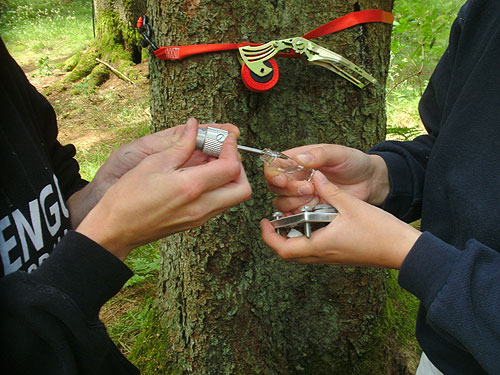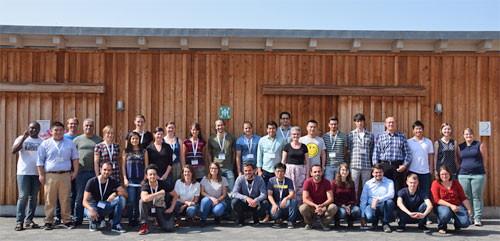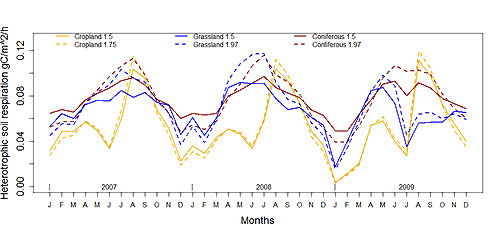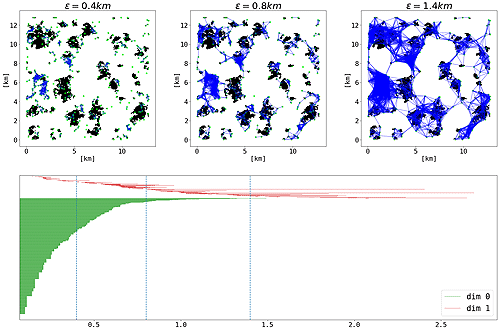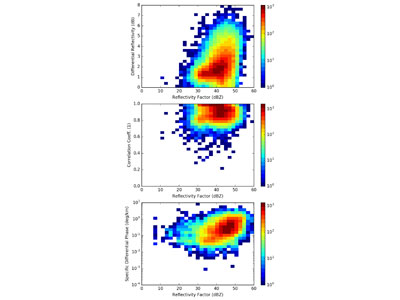Inken Rabbel, Individual training on microcore preparation and analysis
| Picture: Microcore sampling from a Norway spruce tree in the Wüstebach catchment, Eifel National Park. © Neuwirth 2018 |
Event dates: two weeks in September/October 2018 (10.-14.09.2018 and 15.-19.10.2018)
Event location: Eifel National Park (sampling) and Dendro Labor Windeck (sample preparation and analysis)
Author name: Inken Rabbel
Author project: Analyzing feedbacks in a forest soil-vegetation-atmosphere system
Author position: PhD student in C1
Author institute: Department of Geography, University of Bonn
Within the TR32 and for my PhD project, we have used dendrometers to monitor intra-annual growing patterns of different tree species over years. One current challenge in dendroecology is to put such short-term observations into context with long-term inter-annual growth variations as obtained from tree ring data. A possibility to close the gap between the high resolution dendrometer data and the annually-resolved tree ring data is the analysis of actual cell growth in intermediate time steps. To this end, small samples of wood (microcores) need to be taken from the developing current year tree ring in bi-weekly or shorter time steps. On the basis of the resulting intra-seasonal microcore chronology, tree rings can be resolved intra-annually and actual cell growth can be related to the shape of the dendrometer curve
Shari van Treeck, ABC/J Summer School Hydrogeophysics
| Picture: A.Klotzsche |
Event name: ABC/J Summer School Hydrogeophysics
Event dates: 27.8.-31.8.2018
Event location: Jülich, Germany
Author name: Shari van Treeck
Author position: PhD student
Author institute: Geophysics, Steinmann Institute, University of Bonn
Author project: B6
The Hydrogeophysics Summer School focused on geophysical methods that are used to observe soil water content and fluid flow in the subsurface. During the first two days we had lectures about the basics and some case studies of the different methods. The speakers were Sarah Garré (Liège University), Yudi Pan (Karlsruhe Institute of Technology), Sander Huisman (Forschungszentrum Jülich (FZJ) / University of Stuttgart), Jan van der Kruk (FZJ, RWTH Aachen), Christian von Hebel (FZJ) and Anja Klotzsche (FZJ). The methods presented were surface and borehole ground penetrating radar (GPR), electromagnetic induction (EMI), electrical resistivity tomography (ERT), spectral induced polarisation (SIP) & electrical impedance tomography (EIT) and seismics.
Nele Meyer, International Cooperation Grant
| Figure: Replacing the fixed Q10 value of 1.5 by land use specific values has considerable effects on modeled heterotrophic soil respiration. |
Dates: 01.07.2018 – 22.08.2018
Location: National Center for Atmospheric Research (NCAR), Boulder, Colorado, USA
Author name: Nele Meyer
Author position: Postdoc
Author institute: Institute for Crop Science and Resource Conservation, Soil Science and Soil Ecology
Author project (working) title: Spatio-temporal patterns of Q10 values for improved modeling of heterotrophic soil respiration
The goal of B3 during the 3rd phase of TR32 was to unravel the spatial variability of the temperature sensitivity (Q10) of soil respiration in the Rur Catchment. We found that Q10 is mainly a function of land use. Within the Community Land Model (CLM), however, the Q10 value is still represented as a fixed value of 1.5. Thus, we aimed at replacing the fixed Q10 value in CLM value by land use specific values.
José Luis Licón Saláiz, Summer School on Topological Data Analysis and Persistent Homology
| Illustration 1: An example of a Vietoris-Rips filtration, a geometric object central to TDA, constructed using point data from a shallow cumulus cloud field (top row). Also shown is its corresponding barcode, one representation of the information extracted by using persistent homology (bottom). Image author: Jose L. Licon Salaiz |
Event name: Summer School on Topological Data Analysis and Persistent Homology
Event dates: June 11th – 15th, 2018
Event location: Levico Terme, Italy
Author name: José Luis Licón Saláiz, PhD student at University of Cologne, Mathematical Inst.
Author project: C7
This summer school was a one-week gathering of researchers and students in the area of topological data anlysis (TDA) to discuss the current state of the field. Every day consisted of two theoretical lectures and one practical session, where the theory was illustrated using software and real-world data. The lecturers were John Harer (Duke University) and Steve Oudot (INRIA Saclay), and they covered subjects ranging from algorithms for TDA, its connections to statistics and machine learning, and a category-theoretical view on persistent homology aimed at generalizing to multidimensional persistence. Attending the school was particularly beneficial because, as the field is very new and rapidly evolving, it is hard to get a good overview of all the theory and techniques involved. This is important for me because I am currently using TDA to study the spatial structure of atmospheric turbulence and the distribution of cloud fields. It was also a good opportunity to exchange ideas with other young researchers, especially Henri Riihimäki (Tampere Unviersity of Technology/KTH Stockholm), with whom I am working on the statistical representation of topological information, and Grzegorz Muszynski (Lawrence Livermore National Laboratory), who is using TDA to detect patterns in large-scale climate models.
Nele Meyer, Statistic course for soil scientists
Event dates: 09.03.2017-14.03.2017, 28.03.2017-29.03.2017, 27.03.2018-29.03.2018
Event location: Witzenhausen, Germany
Author name: Nele Meyer
Author position: Postdoc
Author Institute: INRES-Soil Science, University of Bonn (B3)
Project working title: Spatio-temporal patterns of Q10 values for improved modeling of heterotrophic soil respiration
Between March 2017 and March 2018, I attended four statistic courses, which were organized and led by Prof. Dr. Bernard Ludwig in Witzenhausen. These workshops were especially important for me as statistics are part of my everyday work. Especially the focus on statistical problems related to soil science attracted my interest and motivated me to attend these workshops.
Matthias B. Schmidt, International Cooperation Grant to the National Severe Storms Laboratory in Norman, Oklahoma
| Differential reflectivity, correlation coefficient and specific differential phase along reflectivity factor of Essen C-band radar from 2016-06-24. The data is filtered by a 35db signal-to-noise threshold and excludes data from radials, which may contain hail or are in the shadow of hail. Presence of hail aloft was checked by estimating specific attenuation and presence of anomalously high specific differential phase. |
By: Matthias B. Schmidt, Meteorological Institute, University of Bonn
Date: 03/09/2017 - 01/10/2017
Locations: Norman, Oklahoma, USA
Differences in scattering behavior between S- and C-band radars is known to exists. However, comparing polarimetric variables (like reflectivity factor Z, differential reflectivity ZDP, crosscorrelation coefficient ρhv and specific differential phase KDP) calculated by a T-matrix backscattering simulation fed with disdrometer data, a severe discrepancy between the two radar systems is observed: Big drops (with reflectivity factors above 45 dBZ) in C band seem to look like ice particles considering the simulated polarimetric variables. For reflectivity factors of 45 dBZ and above, ρhv drops in C band, while it does not in S band. Also, differential reflectivity ZDP increases up to 8 dB and KDP drops too. Considering this effect, distinguishing liquid and frozen particles in hailstorms can become difficult in C band, as big drops usually occur close to hail in hailstorms.
To investigate this topic, picked events of the German radar network of the German weather service (DWD) will be looked into for such scattering behavior. Events where no hail was reported have been selected to investigate scattering of big drops. Also, a C-band and an S-band radar in Alabama, which are only 43km apart and therefore almost collocated, are utilized as well. In radials around hail, where big drops should be very likely, the theoretical predicted change in variable values should be quite visible in C band, while S band should clearly show rain characteristics. This will be monitored by observing KDP.
For further information, please contact:
|
Nadine Horst IRTG Coordinator |
University of Cologne
Institute for
Geophysics and Meteorology Albertus-Magnus-Platz D-50923 Cologne |
|

